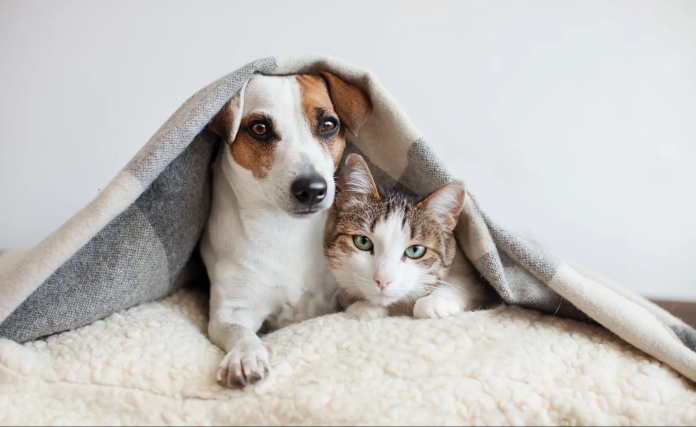Understanding your dog or cat’s signals is important, but they can sometimes be difficult to read. You might think you know what your pet needs from a purr or wagging tail, but you might very well be wrong. Here a few pet myths and truths that will help you give them the attention they need:
A tail-wagging dog is a happy camper. Not so much! The speed and intensity of a dog’s tail wag can also provide important clues to their feelings. Although a wagging tail is commonly interpreted as an expression of happiness, it can occasionally signal feelings of stress or fear. When your dog’s tail is tucked between its legs and wags slowly and close to the ground, it might signify a sense of unease or apprehension.
A slow, gentle wagging usually implies they are relaxed or content, while a hurried, vigorous wag indicates excitement or joy. Similarly, if the tail quickly twitches back and forth, this may indicate aggression or fear. Identifying this behavior is crucial in understanding when your dog requires additional comfort or reassurance.
A purring cat is happy. Don’t count on it! Cats purr whenever they’re happy, even while they’re eating. Sometimes, however, a cat may purr when they’re anxious or sick, using their purr to self-soothe.
When dogs lick their wounds, healing occurs more quickly. Well, yes and no. Licking a wound is instinctual for a dog because they can’t care for themselves with salves. Dog saliva contains some beneficial materials that can help promote healing. It contains a protein called tissue factor (also called platelet tissue factor) that can help promote blood clotting. Dog saliva also contains Opiorphin, which acts as a painkiller.
Dogs have billions of bacteria inside their mouth, and many can also cause infections. Bacteria that are harmless inside your dog’s mouth such as pasteurella can cause serious infections if introduced into a wound. Surgery sites are especially dangerous when it comes to licking since it can break down sutures and reopen the wound.
Prevent your dog from licking their wounds by using an E-collar, bandage, or distraction techniques.
When pets itch, they have fleas. Not necessarily! Many pets are itchy because they have an allergy to some substance. Pets can also itch due to such conditions as pruritis which if left untreated, can result in a “hot spot” that is damaged, oozing, dry, due to excessive scratching, rubbing or licking. Find out what is causing your pet’s itch and resolve the issue.
When dogs yawn, they are tired. Not all the time. Whether you believe it or not, a dog’s yawn can frequently signal stress or anxiety. If your pet unexpectedly begins yawning in a tense scenario, like when encountering unfamiliar people, they’re likely feeling swamped and uncertain about how to react. Providing them with a soothing diversion, such as treats or a leisurely stroll, can make a notable difference. This approach will aid them in achieving a greater sense of relaxation and comfort.
A sniffing dog is curious. Nope. Sniffing is a favorite pastime for dogs and can give us valuable clues about their emotional state. If your pet sniffs around more than usual, it could feel stressed or anxious. According to animal behavior consultants, give them something calming to focus on, such as a toy or treat.
A cat’s tail is telling. All the time! A cat’s tail is a powerful communication tool, and each tail position conveys distinct messages.
- Tail Up: An erect tail is usually a sign of friendliness, and a tail that is up but hooked at the tip may mean cautiously optimistic. Up and quivering indicates that the cat is either spraying or happy and excited. However, up and bristled means the cat is feeling aggressive.
- Tail Straight Out: When striking or hunting, either during play or an offensive attack, a cat will hold its tail straight out. Side-to-side swishing often accompanies this position.
- Tail Down: Typically, the lower the tail, the less happy the cat. When the tail is straight out for the first couple of inches and then down, generally, the cat is showing defensiveness. If the tail is between the legs, the cat is showing submission, and it could be an attempt to protect the belly and/or keep the tail away from injury.
A barking dog means someone is at the door. Maybe not. Barking is perhaps the most well-known dog vocalization. Different barks can mean different things. A short, sharp bark might indicate alertness, while a prolonged, high-pitched bark could indicate excitement or anxiety. Pay attention to the context and accompanying body language to accurately interpret your dog’s barks.
How to recognize when your pet is ill
Besides the typical signs of a pet’s illness that can include vomiting, a loss of appetite, and lethargy, there are physical signs as well that should not be ignored:
- The physical first sign of illness in cats is often a change in body language. Your cat may lie in a crouched position with their head and ears down. If they’re in pain, they might lie in a way to avoid making it worse. Their eyes might look dull or glassy, and their ears will droop to the sides of their head.
- Signs that your dog isn’t feeling well can include excessive panting, whimpering, trouble walking, and your dog’s need to seek a safe space to hide.
For more information about your pet, contact The Humane Society of the United States.











